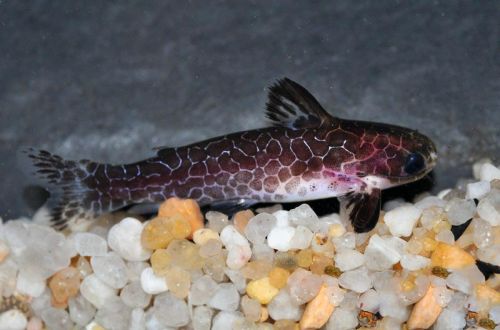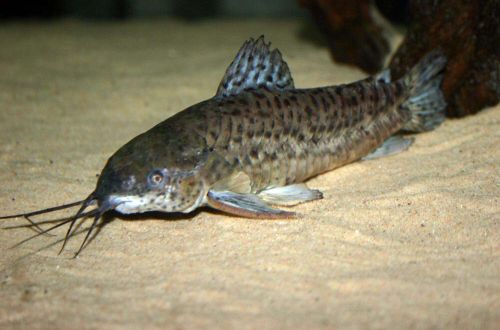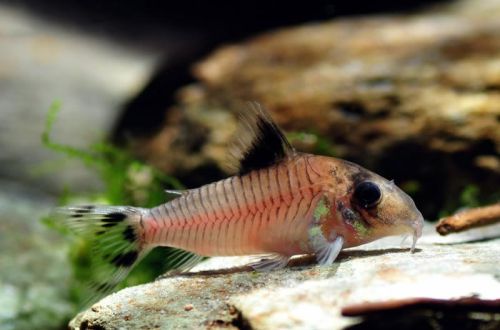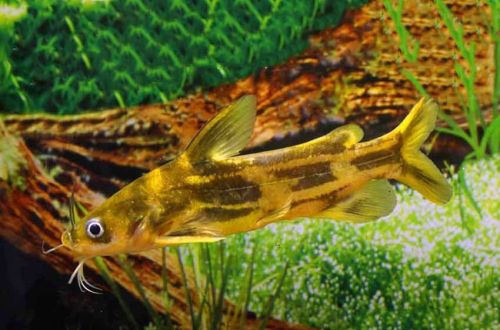
Reticulated spear catfish
The Reticulated Spear Catfish or Purple Oil Catfish, scientific name Centromochlus reticulatus, belongs to the family Auchenipteridae (Occipital Catfishes). Easy to keep and breed, compatible with many other freshwater fish. The combination of these factors along with the original coloration makes it a good choice for the beginner aquarist.

Contents
Habitat
It comes from South America from the territory of Guyana. Inhabits the basin of the small river Rupununi, one of the tributaries of the Essequibo. Probably, the natural habitat is much wider, but there is no reliable data. It prefers sections of the river with a slow current and numerous shelters in the form of heated trees and roots. It leads a nocturnal lifestyle, hiding in the daytime among snags.
Brief information:
- The volume of the aquarium – from 200 liters.
- Temperature – 22-28°C
- Value pH — 5.0–7.5
- Water hardness – 2–12 dGH
- Substrate type – rocky or sandy
- Lighting – subdued
- Brackish water – no
- Water movement is weak
- The size of the fish is 7–8 cm.
- Food – any food
- Temperament – peaceful
- Keeping in a group of 8 individuals
Description
Adults reach a length of about 7-8 cm. The fish have a torpedo-shaped body and short small fins, the first rays of which have changed into sharp spikes. The word “spearman” in the name of the species just points to those very spikes. The coloration consists of large dark burgundy spots between which white streaks pass. Belly silvery. Sexual dimorphism is weakly expressed, males and females are almost indistinguishable.
There is another, not the most obvious name for this catfish, associated with its appearance – “Purple oil catfish”. Similar colors and patterns resemble oil stains on the surface of the water.
Food
An omnivorous species, in a home aquarium it will accept most popular foods. Unlike other catfish, it can feed not only at the bottom, but also in the water column, near the surface.
Maintenance and care, arrangement of the aquarium
The optimal size of the aquarium for a group of 7-8 individuals starts from 200 liters. The design is arbitrary, provided that several shelters or shaded places are provided according to the number of catfish using snags, various decorative objects, thickets of plants. Although in nature it is active only at night, once acclimatized, it will often appear in the daytime, so there is no need to install a separate “evening” lighting.
Keeping the Reticulated Spearfish Catfish is quite simple if the fish is in a suitable environment. It is important to ensure stable water conditions within the allowable range of temperatures and values of hydrochemical parameters. To this end, the aquarium is equipped with all necessary equipment and regular cleaning procedures are carried out.
Behavior and Compatibility
Peaceful calm species, compatible with other small calm fish. Very sociable catfish, so it is recommended to maintain a group size of at least 8 individuals.
Breeding / breeding
Breeding in a home aquarium is possible. Representatives of the Occipital catfish family, to which this species belongs, have developed an unusual method of reproduction – internal insemination. The female can take a portion of the seed from the male and carry it inside along with unfertilized eggs for a long time. When the external conditions become the most favorable, fertilization occurs and a clutch is formed. Parental instincts are not developed; immediately after the end of spawning, the female swims away.
Fish diseases
The cause of most diseases is unsuitable conditions of detention. A stable habitat will be the key to successful keeping. In the event of symptoms of the disease, first of all, the quality of the water should be checked and, if deviations are found, measures should be taken to correct the situation. If symptoms persist or even worsen, medical treatment will be required. Read more about symptoms and treatments in the Aquarium Fish Diseases section.





